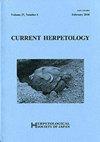Rock Installation Reduces Aggressive Behavior in Captive Hawksbill Turtles
IF 0.7
4区 生物学
Q4 ZOOLOGY
引用次数: 1
Abstract
Abstract: Captive breeding programs are utilized worldwide for the recovery and conservation of endangered species, including the critically-endangered hawksbill turtle (Eretmochelys imbricata). However, aggression is an issue that is commonly reported among captive hawksbill turtles housed together. In the present study, we installed rocks in a captive environment to assess whether they can suppress aggressive behavior in captive hawksbill turtles. The behavior of immature female hawksbill turtles (n=6) was recorded over a 10 d period (between 0900 and 1700 h daily) in an experimental tank under the following conditions: (1) housed alone or paired with another individual in the (2) presence and (3) absence of rocks. Resting behavior was recorded as the total amount of time spent resting per day, while hiding and biting behaviors (i.e., aggressive behavior) were recorded as the total number of events observed per day. Serum corticosterone concentrations were measured at 0900 and 1700 h daily throughout the experimental period. The median number of hiding and biting events was significantly lower for paired individuals housed in the presence of rocks than that for those housed in the absence of rocks. Although no significant differences in serum corticosterone concentrations were observed among the experimental groups, paired individuals spent significantly more time resting in the presence of rocks. Our results suggest that underwater rock installations effectively reduce aggression in captive hawksbill turtles.岩石装置减少圈养玳瑁龟的攻击行为
摘要:世界各地都在利用圈养繁殖计划来恢复和保护濒危物种,包括极度濒危的山楂龟。然而,攻击性是圈养在一起的山楂龟中常见的问题。在目前的研究中,我们在圈养环境中安装了岩石,以评估它们是否能抑制圈养霍克斯龟的攻击行为。在以下条件下,在实验箱中记录了10天内(每天0900至1700小时)未成熟雌性山楂龟(n=6)的行为:(1)在(2)有岩石和(3)没有岩石的情况下单独或与另一个体配对饲养。休息行为记录为每天休息的总时间,而躲藏和咬人行为(即攻击行为)记录为每天观察到的事件总数。在整个实验期间,每天0900和1700小时测量血清皮质酮浓度。居住在有岩石的环境中的配对个体的躲藏和咬人事件的中位数明显低于居住在没有岩石的环境下的配对个体。尽管在实验组之间没有观察到血清皮质酮浓度的显著差异,但配对个体在岩石存在的情况下休息的时间明显更长。我们的研究结果表明,水下岩石装置可以有效地减少圈养的山楂龟的攻击性。
本文章由计算机程序翻译,如有差异,请以英文原文为准。
求助全文
约1分钟内获得全文
求助全文
来源期刊

Current Herpetology
Agricultural and Biological Sciences-Animal Science and Zoology
CiteScore
1.20
自引率
14.30%
发文量
20
期刊介绍:
Current Herpetology publishes original research articles on amphibians and reptiles. It is the official journal of the Herpetological Society of Japan and is a continuation of Acta Herpetologica Japonica (1964–1971) and Japanese Journal of Herpetology (1972-1999).
 求助内容:
求助内容: 应助结果提醒方式:
应助结果提醒方式:


